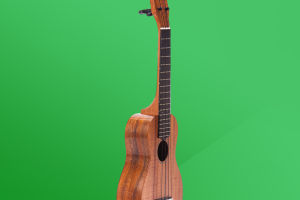The ukulele is a small, four-stringed plucked instrument.
Despite its modest size and appearance, the ukulele has captivated countless music enthusiasts and professionals alike with its bright, cheerful sound and diverse playing techniques.
This article explores various ways of playing the ukulele, tracing its origins, development, and modern applications.
The ukulele was originally brought to Hawaii from Portugal in the late 19th century. It was a Portuguese folk instrument known as the 'Cavaquinho.' With the arrival of Portuguese immigrants, this instrument quickly gained popularity in Hawaii and underwent a series of adaptations and improvements. Over time, the ukulele's shape and size evolved, and it spread to other countries and regions, becoming a globally recognized instrument.
As a small instrument, the ukulele offers a wide range of playing styles, covering various genres and techniques. Here are some primary playing techniques:
(a) Strumming:
Strumming is one of the most common playing techniques for the ukulele, often the first skill beginners learn. It involves quickly brushing across the strings with the fingernails or thumb of the right hand (for right-handed players) or left hand (for left-handed players), producing continuous and rhythmically strong chord sounds. This technique is suitable for accompaniment and playing popular music, creating a relaxed and pleasant atmosphere.
(b) Fingerpicking:
Fingerpicking is a more complex and technically demanding playing style, commonly found in traditional Hawaiian music and some intricate compositions.
Players use the fingertips or fingernails of the right hand (or left hand for left-handed players) to individually pluck each string of the ukulele, creating rich melodies and harmonies. Fingerpicking requires good finger flexibility and coordination and is used in expressive and melodically complex musical pieces.
(c) Chucking:
Chucking is a special playing technique where the player quickly and lightly mutes the strings with the right hand (or left hand for left-handed players), creating a percussive sound that enhances the rhythmic feel and dynamic variations of the music.
This technique is common in pop music and modern styles of ukulele playing, injecting more energy and creativity into the music.
(d) Slides and Vibrato:
Slides and vibrato are techniques used to enhance musical expression.
Slides involve sliding the fingertips of the left hand (or right hand for left-handed players) between notes, creating smooth and coherent pitch changes. Vibrato involves quickly oscillating the finger to intensify the expression and emotion of the notes. These techniques are common not only in ukulele playing but also in other string instrument performances.
(e) Chords and Solo Playing:
The ukulele is not only used for accompaniment but also as a solo instrument. Players can improvise or perform existing pieces using various chords and harmonies.
In chord playing, the ukulele is often used to create soft harmonic backgrounds to support the main melody instrument or vocalist. Solo playing focuses more on showcasing the instrument's tone and technique, often combining multiple playing styles and techniques to create rich musical effects.
(f) Applications Across Musical Styles:
The diverse playing techniques of the ukulele allow it to be used in various musical genres.
From traditional Hawaiian music to pop, rock, and even jazz, the ukulele finds its place. Different playing styles and techniques provide musicians with ample creative and expressive space, giving this small instrument unexpected musical versatility and adaptability.
The ukulele, originating from Hawaii as a traditional instrument, showcases its rich musical charm and expressive power through its diverse playing techniques.
From simple strumming to complex fingerpicking and vibrato techniques, the ukulele is suitable for both beginners and advanced players, challenging their technical skills and creativity. Its bright and crisp sound adds unique color and charm to various musical styles.
As the music industry continues to pursue diversity and innovation, the popularity of the ukulele is growing globally, making it an indispensable part of modern music production and performance.


